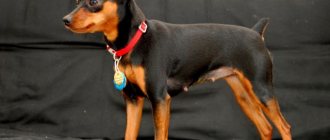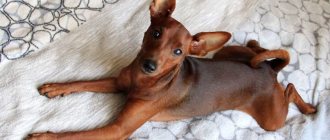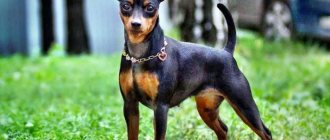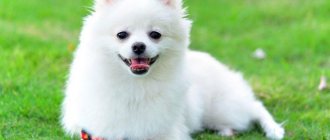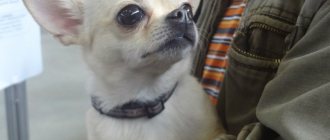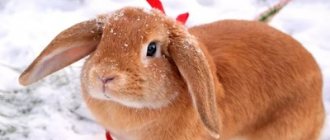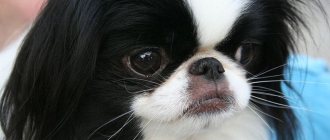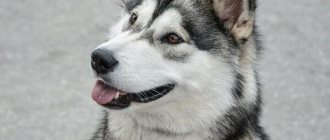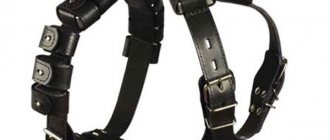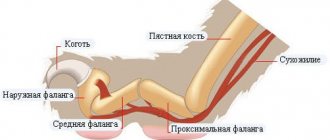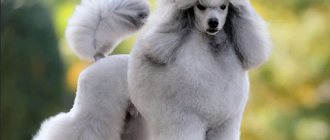When you hear the words “miniature pinscher,” many people think of a small dog. However, not everyone knows what good security qualities it contains. This is a very loyal, cheerful and active dog, gets along well with children. Having chosen a miniature pinscher, you can be sure that this dog has all the makings of an aristocrat. She will become a faithful companion for many years.
Description of the Miniature Pinscher breed
Popularity 89th place among 263 dog breeds
Lifespan:
13-15 years old
Height:
25-30 cm
Country of origin:
Germany
Average price:
15-25 thousand rubles
Weight:
4-6 kg
Latest articles Cat health
Ataxia in cats: what it is, how it manifests itself and is treated 01/23/2022 151 0 0
Cat health
Leukemia, or viral leukemia in cats 01/23/2022 140 0 0
Advantages and disadvantages
- Pros:
- hardy and unpretentious in nutrition;
- high protective instinct;
- suitable for keeping in small apartments;
- weak shedding;
- loves children;
- developed intelligence and high learning ability.
- Minuses:
- jealous character that makes it difficult to get along with other pets;
- the need for daily physical activity;
- tendency to damage furniture and shoes;
- does not tolerate frost well;
- Difficulty in training due to dominant nature.
Key facts
The description of the miniature pinscher breed says that the shortened name came from Germany, which is considered the country of origin of the miniature pinscher. The word "zverg" is often found in the original fairy tales of the Brothers Grimm. For example, the famous Rumplestiltskin is the same “miniscent”, that is, a dwarf. In this regard, other names for the breed include dwarf or miniature pinscher.
The dimensions of the miniature pinscher are 4-6 kg in weight and 25-30 cm in height. Females should be smaller than males. The lifespan of a miniature pinscher is at least 13 years. If the basic rules of care are followed and there are no congenital diseases, pets live for about 15 years.
The characteristics of the miniature pinscher breed include not only a description of external data, but also character traits. You also need to get to know them before getting a dog.
Life with a playful and life-loving miniature is full of adventures. An endless charge of energy always flows over the edge, so the dog gets along well with children and teenagers. She is ready to support any crazy ideas of her owners or encourage them to take an adventure. The mini pinscher is not at all embarrassed by his size, so he is not averse to competing with a larger opponent or trying to seize power in your home. Timely education will help to cope with dominant behavior, strengthening the authority of the owner in the dog’s head.
Application of "Mini Doberman"
The pocket pinscher, although miniature in size, is not suitable for the role of a decorative dog that will accompany at events, sitting calmly in the owner’s arms.
Mini Doberman
The scope is quite wide. They have developed guard qualities, courage and intelligence, which allows them to perform official duties. In addition, although they are not a hunting breed, they are highly trainable. Thanks to this, they can be taken on small game hunts.
In a private home, they can take on hunting responsibilities independently. Miniature pinschers will not only catch mice, but also rats even larger than themselves . The dog can also serve as an alarm system due to its protective qualities, notifying its owners with loud barks about strangers entering the owner’s territory.
History of the origin of the miniature pinscher
Short-haired German pinschers, known in European countries back in the Middle Ages, took part in the formation of the breed. The first written mention of a miniature dog dates back to the 15th century, and Germany is recognized as the country of origin of the breed. To obtain more modest dimensions, breeders crossed standard pinschers with Italian greyhounds and dachshunds. As a result of the experiment, it was possible to achieve a decrease in height at the withers by 10 cm, and by the middle of the 20th century - by as much as 20 cm.
The first standard for the new breed was developed in 1880, but it was not until 1955 that the FCI established it internationally. The Miniature Pinscher is the smallest representative of the Pinschers and Schnauzers group.
Other toy terrier mixes
The Toy Terrier is a very popular breed. Every year more and more people get them. It is not surprising that breeders experiment a lot.
Not long ago, a cross between a Pekingese and a toy terrier appeared. True, it is not particularly popular - the hybrid turned out to be not the most successful. A completely different thing can be said about such a representative of the dog breed as a cross between a Spitz and a toy terrier - he turned out to be compact, cheerful and beautiful, he will make any dog fan fall in love with him.
Of course, many dog breeders treat mixed breeds with understandable prejudice. But if the reader does not plan to attend exhibitions or make a profit from selling puppies, then such a pet can be an excellent choice for the whole family.
Appearance of a miniature pinscher
General impression
The appearance of the miniature must strictly correspond to the description set out in the international standard. Despite this, slight deviations in the appearance and character of dogs are allowed in different countries. Animals from England, the USA and Canada are distinguished by more graceful movements, and the pupils of Israeli nurseries are distinguished by their confident gait and sweeping stride.
Scandinavian miniature pinschers are characterized by a calm and balanced character, and natives from Germany are easy to spot by their stocky and muscular body.
At first glance at the photo of the miniature pinscher, the resemblance to the Doberman is obvious. At the same time, Dobermans have nothing to do with the origin of the miniatures and were bred much later than their little brothers.
Head
Miniature Pinschers are distinguished by their proportional, wedge-shaped head with a distinct stop. The length of the muzzle is slightly shorter than the strong and elongated skull. According to the approved standard, the dog has:
- high-set semi-erect or erect triangular ears;
- brown or black almond-shaped eyes;
- straight bridge of the nose and black lobe with well-developed nostrils;
- dry black lips, tightly fitting to powerful jaws with a scissor bite.
Dogs with cropped ears are only allowed to participate in shows in countries that do not have a law prohibiting cropping. At the same time, docking is not a disadvantage of the breed.
Light eyes, folds on the forehead and low-set ears are unacceptable in the miniature's exterior.
Neck
The head is set on a graceful but strong neck with a noble curve and a smooth transition to the withers. The presence of a suspension is not allowed.
Torso
Purebred dogs have a toned, square-shaped body. The wide, oval-shaped chest protrudes forward expressively, and the sloping back gives compactness to the entire body. Despite possible intrabreed differences, excessive elegance or heaviness are considered a defect.
Forelegs
The forelimbs have a moderately wide set, pronounced angulations, muscular forearms, wrists and pasterns. The elbow joints should not be turned outward or inward.
Hind limbs
The length of the powerful hind limbs exceeds the front ones. The muscles on the wide hips are clearly visible. The paws have a “cat” shape. All fingers are gathered into a ball, and strong claws are painted black.
Tail
The standard allows not only docking of the ears, but also the tail within 1.5-2 cm. The crescent and saber shapes are considered the most advantageous. Animals with such tails receive more points from the judges.
Movement
In the video with miniature pinschers, an energetic and confident gait is clearly visible. The dogs move at a sweeping trot, without slumping their backs.
The prancing step is considered a vice and is not recognized by the FCI, but the English, Canadian and American kennel clubs have a completely opposite opinion on this.
Wool
Miniature Pinschers do not have an undercoat, so the entire body is covered with short and smooth guard hair. Bald patches or curly hairs are unacceptable and are a consequence of crossbreeding with other breeds.
Color
The standard colors of the Miniature Pinscher approved by the FCI include black and tan and fawn. Americans and Canadians have more acceptable options: blue, chocolate and even pinkish-cream with tan, often found in thoroughbred horses.
Marking is acceptable on the chest, lower neck, base of the tail, inner thigh, base of the paws and wrists, and above the eyes.
Size
Gender is easy to identify from a photo. The weight and height of females does not exceed 4 kg and 28 cm. The maximum figures for males can reach up to 5 kg and 30 cm.
The height of the miniature pinscher and the weight of the miniature pinscher allow them to be classified as a small breed, but they are by no means lap dogs. Rather, they can be classified as companions with excellent service qualities.
Character of the miniature pinscher
Life on the street is not about the miniature pinscher. This pocket Doberman cannot do without warmth and comfort, so it is recommended to keep it in an apartment or your own home. In winter, you cannot go outside without protective overalls, since the missing undercoat prevents heat retention. The dog is vulnerable not only to low temperatures, but also to drafts, so its place should be in a well-protected place.
The dominant nature of the Miniature Pinscher can be a real problem when walking. If you walk your pet without a leash, he will definitely try to get into trouble. The feeling of fear is unfamiliar to him, so the dog can enter into a fight with a larger opponent. At the same time, you cannot call him reckless. In unequal conditions, the miniature pinscher acts only to protect the owner.
A puppy cannot do without socialization. If a baby grows up surrounded by other animals from childhood, then he is able to make friends even with cats. Under no circumstances is friendship with birds and rodents possible. If kept together with a miniature, they can die from its sharp teeth.
The playful and emotional pet loves to be the center of attention and gets along well with children. You should not leave your dog only with preschool children. If the culture of careful treatment of animals has not yet been instilled, the child may suffer. The Miniature Pinscher will not tolerate unpleasant actions from its small owner.
Miniatures have an innate desire to manipulate. Lack of training in childhood will affect the adult dog, so try to prove that you have the last word in the house.
Popular nicknames
In Rus', in such cases they say, even if you call it a pot, just don’t put it in the oven. It is clear that you cannot name a dog Vasily Ivanovich, although this also happens. In the circus, for example. And the nickname Kashtanka is only suitable for a fawn-colored miniature pinscher. Yes, and today only that same “deer” with an incomplete secondary school or just a written original will not be ashamed to call his “German” that way.
That’s why the nicknames now in use are increasingly foreign, English-speaking. And here, who cares: here you have Artie (which means Artemon - the Red Count is turning over in his grave), and Buddy (like, Buddy), and Jumper (that is, Jumper) and so on and so forth - this is all for boys, and for girls - well, let's say, Iris (they say, Toffee), Cleo (the hint is clear), Emma (hello to Johann Strauss “numero duo”!) and so on “with all the stops”.
Education and training
When training and raising a miniature pinscher, patience is required. The cunning pet quickly notices the owner’s weaknesses and skillfully plays on them. Don't allow yourself any slack. If there is a ban on sleeping in the master's bed, then it cannot be violated from the very beginning. Otherwise, you will have to frantically figure out how to wean an adult pet from jumping on sofas and beds.
More detailed education begins at 3-4 months. The high intelligence inherent in the breed contributes to the successful performance of exercises even at such a young age. Show authority to gain your dog's respect. More complete information about the nuances of training can be obtained from a dog handler.
The kennel club tells in detail how to raise an obedient pet with a stable psyche. The best reviews are received by joint classes with a pet on an individual basis, where all attention is focused on the formation of an unbreakable bond between man and dog.
Never use force during training. Cruelty to animals undermines trust, fostering cowardice and aggression. Destructive behavior risks taking out anger on other animals, strangers, and even family members.
With little experience with dogs, it is not entirely clear how to train a pet to use a litter box. Owners are not always ready to go outside in winter, so miniature dogs can be taught to go to the toilet at home. Once accustomed to the diaper, place it in the tray, showing the puppy a new place to relieve itself. Wait until your pet starts to worry and put him in the tray. After a successful operation, be sure to praise the puppy and reward him with a treat.
Sometimes several training sessions are required. The main thing here is not to scold your pet when it makes a mistake. Frightened, the puppy will receive a persistent negative reaction and will avoid the tray with all possible forces.
The first walks on the street begin after six months, when the puppy has received all the necessary vaccinations. It is very easy to toilet train outdoors, as the miniature pinscher quickly adopts the habits of other animals.
A trained pet must know the basic commands from the OKD and UGS course. If you want to master more difficult disciplines, but doubt whether it is possible to train a dog in agility, feel free to start your first lessons. In sports disciplines, miniature pinschers demonstrate amazing speed and agility in overcoming the highest objects.
Key points in training
Training for miniature pinschers is very important, as the dogs have a capricious and domineering character and often display aggression towards strangers. There is no need to delay your studies. Well-developed intelligence allows you to start training from an early age.
If the owner misses time or shows the dog his weakness, the dog will quickly take advantage of this and try to become a leader in the relationship with the person.
During the training process, the owner will need a collar and leash, as well as toys and tasty treats. You can start training your puppy at the age of 3 – 4 months . The dog’s psyche at this time is mobile, the animal easily perceives new things.
Before you take your puppy for a walk, you need to introduce him to the collar. It’s enough to dress him up like a pet at home and let him walk around a little. The same applies to leash learning.
Puppies love to chase toys. This hobby can easily be turned into training by training the “fetch” command. For each correctly performed action, the pet should receive a treat. Other commands that a miniature pinscher should know and perform are “near”, “to the leg”, “sit”, “voice”, “lie down”, “front”, “fu”.
Miniature Pinschers are capable of learning more complex commands: “die”, “hold”, “crawl”. Training is a slow process, so it is better to conduct classes in a playful way.
Read about how to properly train a dog in the article: “Training a puppy: effective methods from dog handlers, learning commands at home.”
Miniature Pinscher Health and Diseases
Possible diseases
Some diseases occur most often in miniatures. These include:
- Perthes disease. It appears in puppies at the age of 4-6 months and leads to atrophy of muscle joints and lameness.
- Hypothyroidism. In a sick pet, hormonal metabolism is disrupted, which is fraught with obesity, hair loss, pyoderma and other possible complications.
- Progressive retinal atrophy. This disease causes gradual loss of vision. In the worst case, the animal may go blind.
- Epilepsy. The dog experiences periodic seizures, accompanied by loss of consciousness and uncontrollable behavior. The treatment method is determined by the severity and duration of the seizures that occur.
- Dislocation of the kneecap. Congenital pathology can be detected immediately after birth, so be sure to ask for an X-ray of the puppy’s limbs before purchasing. Acquired dislocations are caused by injuries.
The breed is characterized by a high life expectancy and strong immunity. It is important for your pet's health to follow the vaccination schedule. Although the annual administration of the vaccine does not guarantee 100% immunity, it significantly facilitates the possible course of the disease. As additional preventative measures, do not forget about treatment against worms and ticks. The fight against helminths should be carried out every quarter, and against fleas and ticks - during the seasons of their activity.
Reproductive health
The first heat occurs at 8-12 months. Despite this, only adults over 20-24 months are allowed to breed. Unlike most breeds, the female is ready for pregnancy earlier than the male is ready to mate. Males are untied only after 2 years. The physiological maturity of pets is determined by the third heat, when the body is strong enough to bear new offspring. Most often, birth occurs 60-64 days after mating.
Owners who prefer to avoid the hassle of breeding puppies are advised to take their dog for sterilization at 6-12 months. The sooner the operation is performed, the greater the chance of preventing the development of breast cancer. If the heat has already begun, then you should wait until it ends and visit the veterinarian.
Features of feeding and diet
Dogs over 1 year old are fed 2 times a day at certain times. You can choose dry food or regular food as your main diet. In order to understand what food to feed your pet, analyze its age and health status.
Puppies are fed high-calorie food designed for animals younger than 12 months, older dogs with bad teeth are fed food with soft granules, animals with pathologies of the genitourinary system are fed food with a low protein content.
Consult your veterinarian regarding serving size. He will explain how many times to feed your pet, based on its weight and the set goal (weight gain, loss or maintenance).
When choosing what food to buy for your dog, pay attention to its purpose. Miniature dogs are suitable for brands designed specifically for small breeds. The required norms are already calculated on the packaging, helping to calculate daily portions.
When feeding naturally, try to ensure that meat makes up at least 40% of the diet. Beef and horse meat are suitable for adult dogs, and chicken for puppies. In addition to animal protein, a dog needs:
- vegetables (pumpkin, zucchini, carrots, beets);
- cereals (oatmeal, buckwheat, millet);
- fermented milk products (yogurt, yogurt, kefir).
Several times a week, meat can be replaced with sea fish and chicken or quail eggs. As a treat, offer fruits and rye crackers - an effective remedy for the prevention of tartar.
One-month-old puppies are fed formula milk, and switch to other calcium-rich foods no earlier than 2 months. Expand your diet gradually to understand whether specific foods can be given without harm to health.
Dogs have a maximum appetite in winter, when more calories are required to heat the body. These days, the usual portions can be increased. Additionally, monitor your pet's weight to rule out sudden weight gain and obesity.
Care and maintenance
The miniature pinscher is not suitable for keeping in an enclosure. An active dog will require a large area in a country house or frequent walks in the city. Walk your pet at least 3 times a day and try to give him the opportunity to roam freely. Too little activity can lead to destructive behavior.
While walking, protect your pet from frost, precipitation and wind. In addition to overalls, buy special shoes that protect your paws from aggressive reagents.
Miniatures shed very little, which makes grooming easier. Combing is done with a soft bristle brush once a week. For shine, wipe the wool with a damp sponge or genuine leather cloth. More global washing is carried out no more than 2 times a year.
In addition to grooming, don't forget about trimming nails, cleaning ears and teeth. To maintain ear posture, massage the auricle daily, moving from the base of the ear cartilage to the very tip of the ear.
The rules for caring for and maintaining a miniature pinscher are simple: activity, care and good feeding. Even a novice dog breeder can handle this without difficulty.
Mating
According to standards, a miniature pinscher female is allowed to breed no earlier than 15 months. Pregnancy lasts 63 days. No significant changes in behavior are observed. Repeated mating can occur after 1-1.5 years, when the mini pinscher girl gains strength, gets stronger and recovers. The last mating occurs at 8 years of age. Frequent childbirth exhausts the dog and significantly reduces life expectancy. During pregnancy, you need to take care of your dog as before, be sure to take walks and monitor its diet. This allows you to train the expectant mother before giving birth.
Tips for choosing a puppy
There are many Russian nurseries that breed miniature pinscher puppies, so you can choose one that is closer to home. To breed the breed, they use not only the breeding class, but also show class representatives who perform at international exhibitions. If you want to raise a future star, then check out the animal’s pedigree. The presence of high-profile titles increases the chances of a successful career for the growing offspring.
Before visiting the kennel, call and find out the age of the puppies for sale. Such consultation will help clarify the seller's responsibility. Up to 2 months, puppies should be close to their mother, since early weaning is fraught with a decrease in immunity and possible mental disorders. The older the puppy, the higher the price, since the final cost consists of all expenses associated with maintenance.
When you first meet, evaluate the situation in the nursery. The room should be clean and spacious. Examine the appearance of the mother and the puppies themselves. All dogs should have a smooth and shiny coat. The presence of receding hairline and bald spots may be the result of parasite infection or a dermatological disease.
If you are confused and don’t know how to choose only one pet and not take them all, start with activity. A playful and good-natured baby, ready to communicate with a stranger, is easier to train. It will be more difficult with more modest and inactive puppies, but they can also be raised into beautiful dogs if you put in the effort.
What traits did she adopt from the toy terrier?
The Toy Terrier has a very elegant physique.
However, a cross between a Toy Terrier and a Pinscher inherited something from its first ancestor. First of all, this is a more graceful physique - the legs are long, the bones are thin. The character of this toy terrier/pinscher mix is also more reminiscent of a terrier. He is more friendly and cheerful - not at all like the gloomy and always serious Pinscher.
In addition, the mestizo turned out to be surprisingly brave. Combined with its increased size, this makes it a good defender - few people imagine that a four-kilogram pet can so fearlessly defend its owner.
How much does a miniature pinscher cost?
The average price of a miniature pinscher offered by Russian nurseries ranges from 10 to 30 thousand rubles. Private sales through free bulletin boards, where the seller indicates a price below 10 thousand, are conditioned by the absence of a pedigree or the presence of a breeding marriage.
If the purpose of purchasing a miniature dog is related to further breeding of the breed, then choose breed-class puppies. The maximum price is set for show-class animals - future winners of international competitions, and the minimum price is for pet-class dogs with small but acceptable deviations in appearance.
Do you like the article? 0
